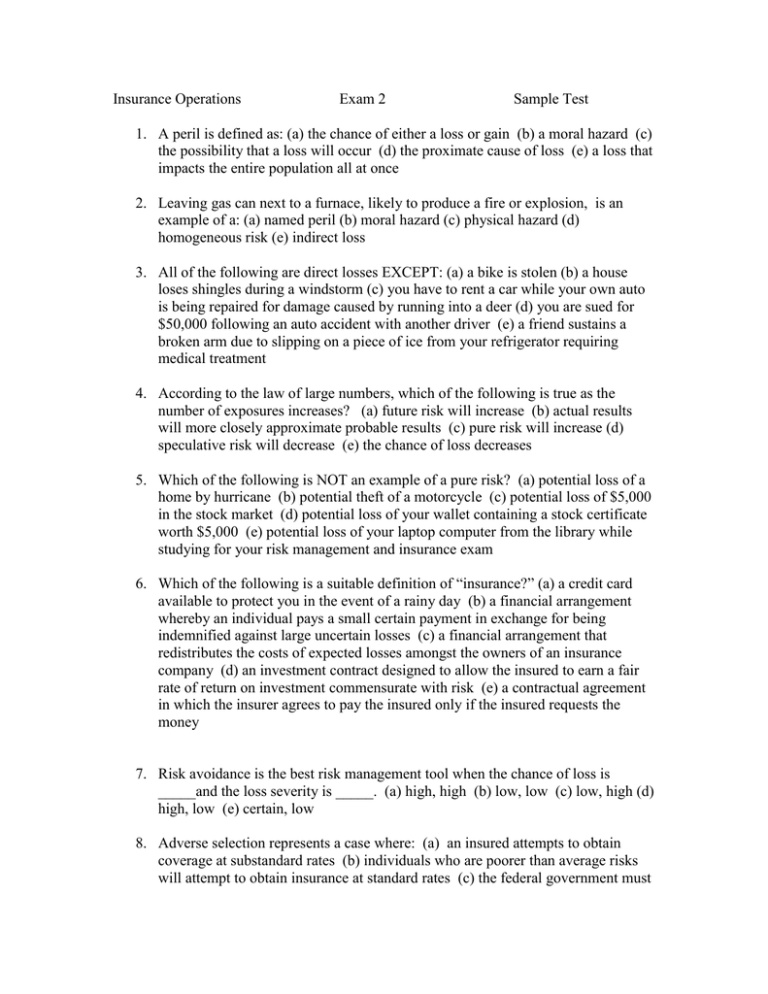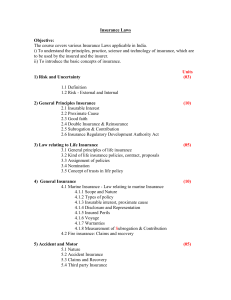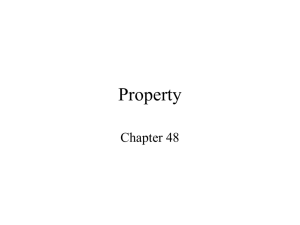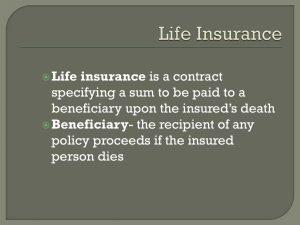Insurance Operations ... 1. A peril is defined as: (a) the chance...
advertisement

Insurance Operations Exam 2 Sample Test 1. A peril is defined as: (a) the chance of either a loss or gain (b) a moral hazard (c) the possibility that a loss will occur (d) the proximate cause of loss (e) a loss that impacts the entire population all at once 2. Leaving gas can next to a furnace, likely to produce a fire or explosion, is an example of a: (a) named peril (b) moral hazard (c) physical hazard (d) homogeneous risk (e) indirect loss 3. All of the following are direct losses EXCEPT: (a) a bike is stolen (b) a house loses shingles during a windstorm (c) you have to rent a car while your own auto is being repaired for damage caused by running into a deer (d) you are sued for $50,000 following an auto accident with another driver (e) a friend sustains a broken arm due to slipping on a piece of ice from your refrigerator requiring medical treatment 4. According to the law of large numbers, which of the following is true as the number of exposures increases? (a) future risk will increase (b) actual results will more closely approximate probable results (c) pure risk will increase (d) speculative risk will decrease (e) the chance of loss decreases 5. Which of the following is NOT an example of a pure risk? (a) potential loss of a home by hurricane (b) potential theft of a motorcycle (c) potential loss of $5,000 in the stock market (d) potential loss of your wallet containing a stock certificate worth $5,000 (e) potential loss of your laptop computer from the library while studying for your risk management and insurance exam 6. Which of the following is a suitable definition of “insurance?” (a) a credit card available to protect you in the event of a rainy day (b) a financial arrangement whereby an individual pays a small certain payment in exchange for being indemnified against large uncertain losses (c) a financial arrangement that redistributes the costs of expected losses amongst the owners of an insurance company (d) an investment contract designed to allow the insured to earn a fair rate of return on investment commensurate with risk (e) a contractual agreement in which the insurer agrees to pay the insured only if the insured requests the money 7. Risk avoidance is the best risk management tool when the chance of loss is _____and the loss severity is _____. (a) high, high (b) low, low (c) low, high (d) high, low (e) certain, low 8. Adverse selection represents a case where: (a) an insured attempts to obtain coverage at substandard rates (b) individuals who are poorer than average risks will attempt to obtain insurance at standard rates (c) the federal government must provide coverage (d) a buyer of an interest rate futures contract loses money as interest rates rise (e) an employer is held responsible for the actions of his/her employees 9. A mutual insurance company is: (a) an insurer that may pay dividends to policyholders (b) owned by shareholders who purchase stock in the business (c) a non-profit business organization (d) not required to file a statutory accounting statement with the insurance commissioner (e) required to abide by a file and use provision in order to set new premium rates 10. Underwriting might best be defined as: (a) the process of taking other people’s money, investing it, and keeping the money (b) the selection of who is to be insured and the determination of an appropriate premium based on risk (c) the determination of coverage after an insured files a claim (d) the process of examining the accounting records of an insurer prior to filing the statutory statement (e) determination of how much to pay on a particular loss based on the principle of indemnification 11. Insurance or risk transfer in best used in risk management when the frequency of loss is _______ and the severity of loss is ______________. (a) low, high (b) high, low (c) low, low (d) high, high (e) uncertain, speculative 12. The most difficult and important step in risk management process and one that can lead to a risk manager being terminated if it is not conducted properly is: (a) risk identification, particularly those risks that are foreseeable (b) finding the least costly insurer to cover all the risks that may impact an organization (c) determining an appropriate premium for the pure and speculative risks (d) selecting the best method for handling risk (e) hiring a highly trained accountant to create a tax-sheltered captive within the organization 13. Lloyd’s of London: (a) is a large property-liability insurance company with headquarters in London (b) sells insurance directly to the public through the mail (c) sells only inland and outland marine coverage to insure transportation risks (d) specializes in life insurance coverage (e) is a marketplace where separate underwriting syndicates accept risk exposures for their own accounts 14. The mailman who visits your property to deliver the mail is: (a) a licensee deserving a higher standard of care than the trespasser (b) is an invitee requiring a lower standard than a licensee (c) a trespasser deserving no standard of care (d) an invitee requiring the highest standard of care because the mailbox is an attractive nuisance (e) an invitee or licensee depending upon the type of mail being delivered 15. An independent agency system for selling insurance: (a) is used by direct writing companies such as State Farm Insurance (b) is used only in life insurance (c) requires agents to be paid a flat salary with little in the way of commissions (d) uses agents who own their own business, receive primarily commission income and own their list of clients (e) is represented by companies writing mostly reinsurance 16. Taking a $500 on your PAP automobile insurance contract is an example of: (a) risk avoidance (b) loss reduction (c) risk assumption (d) risk transfer (e) hedging 17. The principle of utmost good faith: (a) holds only the insurer to a higher standard of honesty in the execution of the insurance contract (b) generally does not apply in health insurance since these covers are administered under group underwriting (c) requires that the insurer fulfill on the promises made in the insurance contact, and that the insured provide accurate information on the insurance application and not withhold information considered material to the contract (d) means that there will be an inequality between the actual value of payments amongst the policy participants (e) requires that the insurer provide the insured with a written contract in order for the policy to come into existence 18. If a property insurance agent knocks on the door of I.M. Covered, explains the contract, and receives a check for the policy that is cashed the following day. Which one of the following most closely has occurred? (a) offer, acceptance, consideration (b) offer, counter offer, acceptance (c) offer, consideration, subrogation (d) offer, acceptance (e) rejection, dejection, ejection 19. Which clause or concept in insurance law provides that when an insurer indemnifies the insured for loss, the insurance company has the right of recovery from a negligent third party? (a) mortgagee clause (b) proof of loss (c) ipsa res loquitur (d) estoppel (e) subrogation 20. Which of the following is NOT a method for settling a casualty insurance claim? (a)actual cash value (b) cost to repair (c) cost to replace (d) insurable interest at the time of loss (e) insurable interest at the inception of the insurance policy 21. The principle of indemnity in insurance means: (a) a person has the right to sue an insurer for loss when they are not satisfied with the payment of a claim (b) that a person may not collect more than his/her actual financial loss in the event of damage caused by an insured peril (c) that a person will not be reimbursed for a loss unless he can show proof of loss (d) an employer is always responsible for the careless acts on an employee (e) a adjusters may not be held liable for twice the claim if a settlement has already been reached on a policy 22. The Medical Payments Coverage under Section 2 in the HO-3 policy covers all of the following EXCEPT: (a) a guest slips and falls on a piece of ice during a birthday party celebration in the insured’s home (b) the babysitter sustains a bite to the arm by the insured’s five year old son while arguing over when bedtime is to be imposed (c) the insured stumbles down the basement stairs while doing the laundry and breaks his arm (d) the insured accidentally hits someone with a golf ball when teeing off from the front of his house and that person needs medical treatment (e) a neighbor’s child injures himself climbing over the insured’s fence and requires stitches in the emergency room 23. Which of the following would be covered under the Medical Payments section of your Personal Auto Policy (PAP)? (a) your car breaks down on 218, and your friend who was riding with you goes to seek help and is struck while walking down the road, by a hit-and-run driver (b) you are hurt while delivering pizzas for the Hippy Dippy Pizza Joint using the company car, and you are eligible to collect worker’s compensation benefits (c) you hurt your hand while changing the spark plugs on your car (d) your daughter is struck by a hit-and-run driver while jogging on Nebraska Avenue near UNI (e) a deer is injured when you hit him as he is crossing 380 near Cedar Rapids 24. The goal of risk management is to: (a) Minimize insurance expenditures (b) Make certain that uninsured losses do not occur (c) Minimize the adverse effects of losses and uncertainty connected with pure risks (d) Get the best buys in the field of insurance (e) Eliminate financial loss 24. You insure your $200,000 home under a HO-3 policy with an 80% coinsurance provision, deciding to purchase $150,000 in coverage. You sustain a $10,000 covered loss. What will be your claim settlement (ignoring any deductible): (a) $10,000 (b) $9,500 (c) $9,375 (d) $7,500 (e) $0 26. In property insurance, coinsurance is: (a) An agreement between two or more insurers to equally share the costs of large losses (b) A contractual agreement to make the insured bear a portion (usually small) of every loss (c) A contract agreement to help equalize total claims to reinsurance premiums (d) A contractual agreement to discourage under-insurance (e) A contractual agreement to prevent first-dollar coverage on small Anuisance@ claims above the disappearing deductible 27. Under the principle of contract of adhesion in insurance: (a) the insured has the opportunity to help write up the insurance contact (b) ambiguities are always construed against the insurer writing up the insurance contract in favor of the insured (c) the insurance company writes the contract with the approval of the state legislature in each jurisdiction where a policy is sold (d) there is an unequal amount of dollars changing hands in the insurance contact (e) the insured is entitled to only the amount of financial loss sustained and no more 28. Loss adjusters do all of the following EXCEPT: (a) investigate claims to determine if fraud is involved (b) negotiate with the insured on the amount of damage claims paid under the policy (c) recommend denial of claims where there is no insurable interest (d) act as the company’s lawyer if the case goes to court (e) interpret the policy provisions covering the loss 29. Bo Hunter, an insured with a $500 deductible collision coverage on his car, sustains an accident with a deer called “Wild Thing,.” while on a hunting trip to Minnesota. The auto suffers $600 damage. In addition to the collision coverage, Bo also has a $0 deductible on the other than collision coverage in his auto policy. Bo can recover from his insurer: (a) $100 (b) Full loss under supplementary Payments up to $500 (c) Full loss of $600 (d) Nothing, this damage is not covered E. $600 less the $500 deductible under the uninsured motorist coverage 30. Which of the following is Not a standard provision on an insurance contract? (a) Declarations (b) Insuring Agreements (c) Conditions (d) Exclusions (e) All-Risk Coverage 31. Harley Davidson decides to set up an arc welding shop inside his garage to earn a little extra money so he can go up to the Sturgis Falls Celebration. Harley has an HO-2 policy on his home. Unfortunately, his garage burns to the ground one night when the motorcycle strut he is welding overheats and causes an explosion. What will happen with this claim according to the HO-2 contract? (a). The fire is a covered peril and the damage will be paid because Harley had an insurable interest in the property at the time of loss (b) The peril of fire is not covered because Harley did not show an insurable interest in the garage at the inception of the policy (c) There will be no payment because the HO-2 policy excludes business pursuits (d) a partial payment will be made based on the indirect damage losses from Harley being unable to continue his business in the garage (e) a full payment will be made because Harley showed insurable interest at the time of loss and the principle of subrogation applies 32. The U.S. Supreme Court Case that established that insurance was not interstate commerce, could not be federally regulated, but rather could only be regulated by the states was: (a) Paul versus Virginia (b) Munn versus Virginia (c) The Southeastern Underwriters case (d) Townsend versus New Hampshire (e) McCarran-Ferguson 33. Which of the following established that the federal government could regulate insurance, but only in those areas vacated by the states: (a) Paul versus Virginia (b) Madison versus Monroe (c) The Southeastern Underwriters case (d) Public Law 15 (e) The McFadden Act © Dr. A. Frank Thompson, November 15, 2012, All Rights Reserved. Exam 2 Answer Key: 1. D 2. C 3. C 4. B 5. C 6. B 7. A 8. B 9. A 10. B 11. A 12 A 13. E 14. A 15. D 16. C 17. C 18. A 19. E 20. E 21. B 22. C 23. D 24. C 25. D 26. D 27. B 28. D 29. C 30. E 31. C 32. A 33. D





